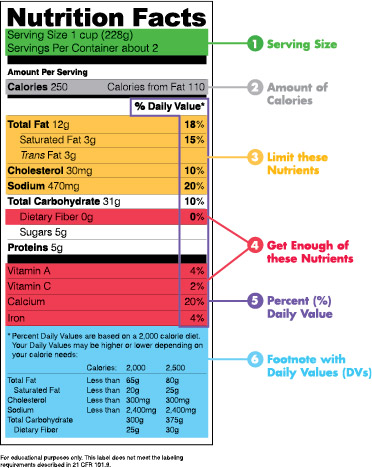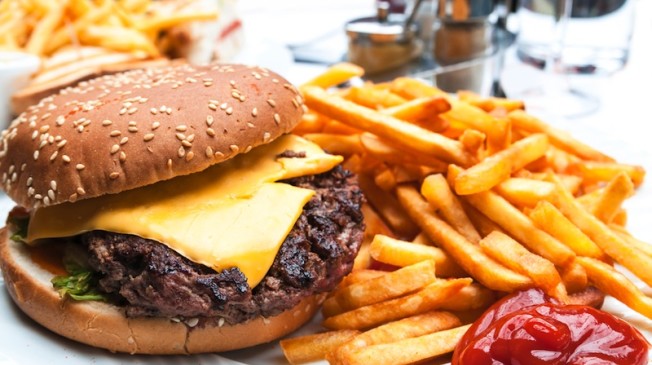39 how to read fats on food labels
How To Read And Understand Nutritional Labels | dbl-diabetes European regulations require that nutritional labels for products show the quantities, per 100 g or 100 ml, of: fat (grams), saturated fat (grams), carbohydrates (grams), of which sugars (grams), protein (grams), salt (grams). Sometimes, these values may also be expressed per serving, but it's not required. Fats, sugar, carbs: Here's how to read food labels for healthy and ... Claims and health-related benefits often approved on food packaging include "no added sugar", "97 percent fat-free", "wholegrain", and "natural", along with a number of tables, numbers and nutrients. Often the information is so dense it is almost as if you need a doctor's degree in nutrition to fully comprehend it all. The good news is […]
Learning To Read Labels :: Diabetes Education Online When you read food labels, the grams of sugar are already included in the total carbohydrate amount, so you do not need to count this sugar amount separately. The grams of sugar listed include both natural sugars, from fruit or milk, and added sugars. On a nutrition food label, the total carbohydrate includes the sugar.

How to read fats on food labels
Food Labels | Nutrition.gov Food and Drug Administration (FDA) regulates the safety of food for humans and animals, including foods produced from genetically engineered (GE) plants, sometimes referred to as "genetically modified organisms" (GMOs). Find out more about the safety of GE plants, and how they are regulated here. How to Read a Nutrition Facts Label | Everyday Health For trans fats, nutrition labels are tricky. "The nutrition facts label can have 0 g listed next to trans fat, as long as the product has less than 0.5 g of trans fat per serving," says ... Understanding Ingredients on Food Labels - American Heart … 06.03.2017 · There are many terms used for sugar on food labels. You might see sugar listed as the fourth ingredient in a product and think it’s not so bad. But sugar can also be listed as high-fructose corn syrup or corn syrup, agave nectar, barley malt syrup or dehydrated cane juice, to name just a few. Read more about sugar and sweeteners.
How to read fats on food labels. How to read a nutrition label, from serving size and added sugars to ... Calories / % daily value. Panjwani: You'll find calories at the top of every label, and the % daily value running down the right side. Calories refer to all the units of energy you get from any source (carbohydrate, fat, protein, alcohol) in a serving of a food or beverage. Calories are now listed larger and bolder at the top of products, so ... How to Read Labels on Food Packages: Facts, Photos ... - CalorieBee 3. Serving Size. This is usually the first item on the food label. It contains information about one serving size or its equivalent. For example, if you open a jar of ice cream, and it says two servings per container, and you consume the whole jar, you have consumed double the amount of items listed on the label. 4. dtc.ucsf.edu › learning-to-read-labelsLearning To Read Labels :: Diabetes Education Online On a nutrition food label, subtract the fiber from the total carbohydrate amount. When you read food labels, the grams of sugar are already included in the total carbohydrate amount, so you do not need to count this sugar amount separately. The grams of sugar listed include both natural sugars, from fruit or milk, and added sugars. Food Labels (for Teens) - Nemours KidsHealth 23.09.2021 · Food labels provide more than just nutrition facts. They also tell you what's in a packaged food (i.e., the ingredients). People with food allergies need to check ingredient lists to avoid foods that can cause an allergic reaction. Some food labels also state which country the food came from, whether the food is organic, and certain health claims.
Fats, sugar, carbs: How to read a food label (and seven ... - Good Food The "total carbohydrate content" of the food will actually include the sugars within this number and give you an idea of the amount of fuel a food contains. For example, if you consider that a slice of bread or a piece of fruit contains 15-20 grams of carbs per serve, then a food that contains 60-80 grams of carbs per serve is an energy-dense ... kidshealth.org › en › teensFood Labels (for Teens) - Nemours KidsHealth Food labels provide more than just nutrition facts. They also tell you what's in a packaged food (i.e., the ingredients). People with food allergies need to check ingredient lists to avoid foods that can cause an allergic reaction. Some food labels also state which country the food came from, whether the food is organic, and certain health claims. How to read nutrition facts on food labels? Food Labels to Read. Step 1: Determine the number of servings and the number of calories per serving. The serving size determines all of the information on a food label. Step 2: Determine the amount of fat in the dish. Step 3: Determine the amount of cholesterol in your system. Step 4: Make sure the sodium level is correct (salt). › how-to-read-food-labelsHow to read food labels | healthdirect Energy: A kilojoule is a measure of energy. To lose weight, you need to eat and drink fewer kilojoules (kJ) than you use. You should limit your intake of discretionary or junk foods — i.e. those that have more than 600kJ per serve.
How to Read Japanese Nutrition Labels - Japan Living Guide How to Read Nutrition Facts on Food Product in Japan. Ingredients and nutritional facts (栄養成分表示, eiyo seibun hyouji) are usually reported on the top left of each product. They show helpful information about your food, such as protein, fat, and carbohydrates. The nutritional information found on a food label is expressed per portion ... How to Understand and Use the Nutrition Facts Label | FDA It's important to realize that all the nutrient amounts shown on the label, including the number of calories, refer to the size of the serving. Pay attention to the serving size, especially how ... The Basics of the Nutrition Facts Label - Academy of Nutrition and ... Step 4: Check Out the Nutrition Terms. Low calorie: 40 calories or less per serving. Low cholesterol: 20 milligrams or less and 2 grams or less of saturated fat per serving. Reduced: At least 25% less of the specified nutrient or calories than the usual product. Good source of: Provides at least 10 to 19% of the Daily Value of a particular ... How To Understand Food Nutrition Labels - restaurantware.com If a food label says that a product is "high in protein," this means that it contains 20% or more of the daily recommended intake. "Very high in protein" means that the food contains 50% or more of the recommended amount. So when you're looking for healthy, high-protein food, be sure to check the label carefully.
› understanding-food-labelsUnderstanding food labels | Diabetes UK The labels show how many calories are in the food or drink and are also colour coded to show whether the food is low (green), medium (amber) or high (red) in fat, saturated fat, sugar and salt. The information on the front of the pack also tells you how the portion of the food contributes to the Reference Intake (RI) of an adult.
How to Read Food Labels and What to Watch Out for? The simpler their ingredients list, the better for you. 2. Nutrition facts table. The nutrition facts table is a very important part of the packaging, because it tells you how nutritionally rich the given food is and how much energy it contains. The energy value must be indicated on the packaging.
How To Read A Food Label Correctly | Your HCG Diet All information on the label is based on the serving size stated. Amount Per Serving - This shows the number of calories found in a single serving. Calories from fat - Food labels show calories from fat so you can limit the amount of fat you eat for a healthier diet. The rule of thumb is that no more than 30% of your daily calories should ...
This Is How to Read a Nutrition Facts Label on the Keto Diet That's not a 33% fat, 33% carb, 33% protein ratio. It's actually 52% fat, 24% carb, 24% protein. This may sound a little confusing, but as long as you limit carbs (the most important part) and aim for healthy fats and protein to make up a majority of your daily macronutrient intake, your results should be excellent.
Fats, sugar, carbs: Here's how to read food labels for healthy and ... An adult's GDA for total sugars is 90g, which includes 50g of added sugars. To have a balanced diet, cutting out fats completely is not a good idea. Fats are essential to some of the body's ...
Daily Value on the New Nutrition and Supplement Facts Labels For the nutrients with DVs that are going up, the %DVs may go down. For example, the DV for total fat has been updated from 65g to 78g. That means that a packaged food with 36g of total fat in one ...
› health › how-read-food-andHow To Read Food and Beverage Labels | National Institute on ... At the top of the Nutrition Facts label, you will find the total number of servings in the container and the food or beverage's serving size. The serving size on the label is based on the amount of food that people may typically eat at one time and is not a recommendation of how much to eat. Read more about serving and portion sizes.
Fats | Nutrition.gov HHS, Food and Drug Administration, Center for Food Safety and Applied Nutrition Read about monounsaturated and polyunsaturated fats - what they are, where they are found, what they do, and how to use the Nutrition Facts Label to replace saturated fat …





Post a Comment for "39 how to read fats on food labels"